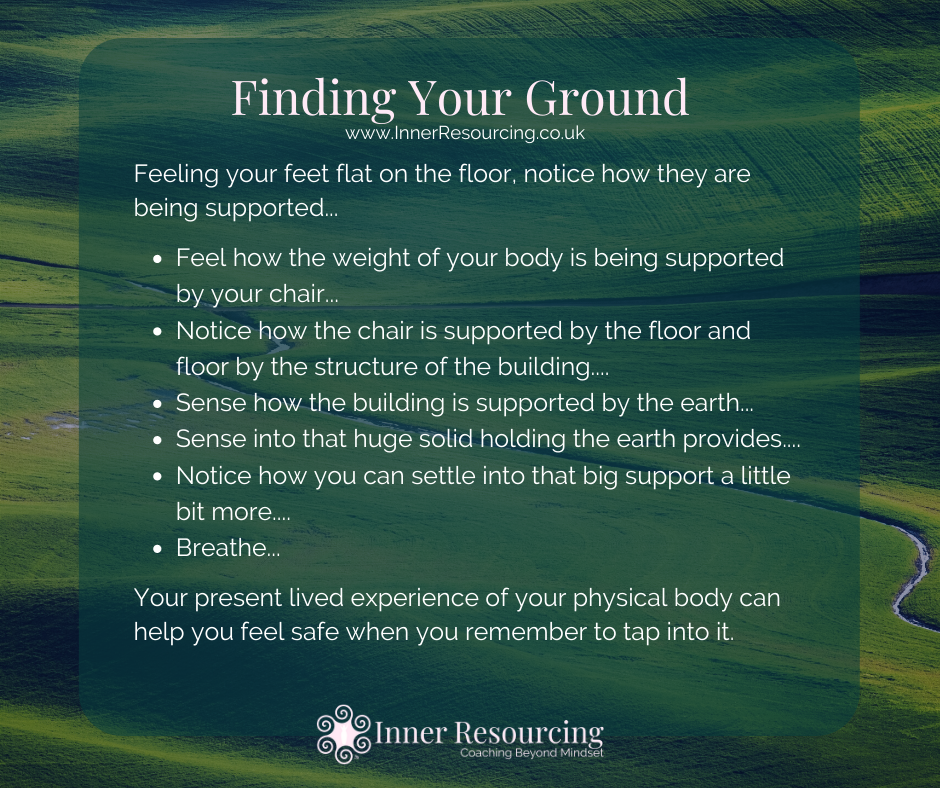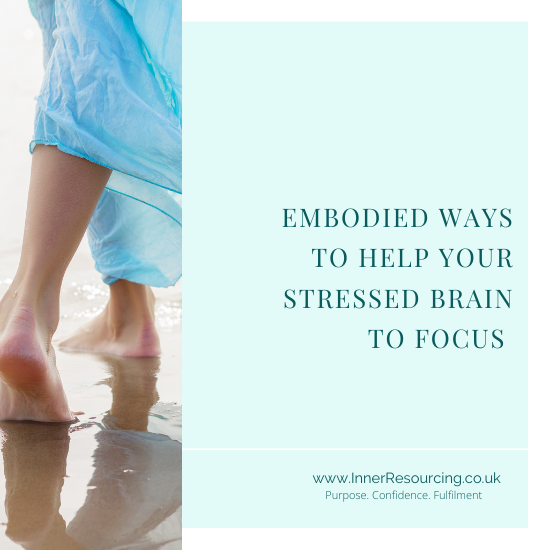Embodied ways to help your stressed brain to focus
In this article, I explain why it’s so tough to focus when stressed out & share a helpful step-by-step embodied process for reducing stress and improving focus. There’s also a guided audio, but I recommend reading the article first. (Jump to the instructions. Or, jump to the audio.)
If you want to be able to not just focus when stressed, but also actually reduce stress and overwhelm, I recommend the “Find Your Poise” program.
Struggling to concentrate when you’re stressed?
Feeling calm, clear, and focused is a natural state. But modern humans spend an awful lot of time feeling wired, scattered, and distracted.
And right now, we’re in a time of pandemic, huge societal change, climate change, etc etc.
So it’s no wonder if you can’t get your head in gear, or your brain in focus.
This lack of higher focus is also a natural state.
Your brain-body system has evolved to protect you from sabre-toothed tigers, marauding invaders, and other dangers. It does this by re-routing resources away from higher abilities (like learning a new skill or deciphering a statistical report) to more basic protection systems. This re-routing means you are reacting from a more primitive part of your brain. (Nice diagram illustrating this here…)
So it’s not really that you can’t concentrate, it’s that your concentration system has been redirected to something else.
This automatic switch keeps us alive. The problem is, most of the dangers modern humans face are on-going. And, we are restricted in the steps we can take to evade them.
Yet we do still need to access our higher abilities to do our jobs, and to function successfully in the 21st century.
We need to be able to focus when stressed.
We want to be able to respond positively to family and clients. We need to wrap our heads round what’s happening in the world, and not just react.
On top of that, not being able to concentrate might make you even more worried. For example, worried that something is wrong with you. Or cross with yourself that you’re not “dealing with it” as well as others around you seem to be doing.
But it’s entirely normal and to be expected that you might feel anxious, or overwhelmed. The proverbial sand is shifting under us all. Especially as we realise that “back to normal” is nowhere in sight.
If you’re already inclined to self-criticism then this difficulty in getting focused when stressed may be triggering an inner critic attack.
If this is you, always remember the inner critic is scared. That’s where its criticism comes from. It needs its hand holding in the way a scared child might need its hand holding. I always recommend a place to start with healing the inner critic is to simply say to it “Yes, I know you’re there, and I’m here with you.“
And just remembering that this is the way in which your system has evolved to work can help.
Most people find it hard to focus when stressed, even without an inner critic getting in on the act.
So I teach my clients a helpful protocol from Experiential Focusing. This can help you change your state to that other natural state of calm, clear, and focused.
I’ve shared this below, so feel free to try it out.
Bear in mind that anything new like this is much easier to learn and implement with specific support. So you might like to check out my one-to-one Find Your Poise programme, or join one of my regular online classes for small groups.
Alternatively if you try it, listen to the audio, and have questions, get in touch here.
Getting Your Focus Back
A preliminary step: learning to ground yourself
This is an important first step, because it can help you to feel safer to be more grounded (through sensing into the way in which your body is here, now, and how it is being supported). I’ve separated it out because you can use it at any time you like to feel more centered and grounded. A sense of safety helps to switch off your automatic rerouting. Here’s an example of the kind of quick grounding process I teach my clients.

You can also use other senses, for instance, looking around the room, noticing that, right at this moment, you are safe.
Deliberately slowing your breathing can also help, creating another body-mind feedback loop that reduces anxiety.
While these are helpful steps, there’s a longer, deeper process called “Clearing a Space” that can help you shift into a calmer, clearer, more resourced state. I’ve outlined this below. This process takes about 10-15 minutes. (As you get more used to it, you can speed through it faster.)
A Helpful Process for Getting Focused/Clearing a Space in which You can Concentrate
Below you’ll find a link to an audio file, where you can listen and relax as I guide you through the process. First, here’s a brief summary of each step.
(NB This might look complicated but is much easier to actually do than describe!)
Clearing A Space
This is a process of getting in touch with yourself, connecting through your body, and identifying in a general sense each thing (life situation, relationship, or issue) that is getting in the way of you being able to focus. Then placing them “outside” of you.
Noticing what’s there
- Start with the grounding process described in the image above. (Pretty much everything we do in Focusing starts with grounding into your body.)
- Then put your attention in the middle of your body, checking in with yourself for “what is stopping me from focusing/concentrating right now – what’s bugging me?”
- There may be several things. Pick one to start with. Don’t unpack it, or get into the story of it, just notice that it’s there.
Getting a handle on it
- Get a holistic, global, “whole thing” sense of it. It will probably be a life situation e.g. “that whole thing about working from home”, or, “all about feeling attacked online”, or a worry or concern: “worrying about losing my job”, “concerned about my children going back to school”.
(Perhaps an image or a metaphor will come about this particular thing e.g. “it’s like a knot in my stomach”, “it’s like a bag of cats all trying to get out”, “it’s like a cold wet mist”. Don’t worry if not, just stick with your “it’s something to do with…” or “that whole thing about …”) - See if you can bring some compassion for that part of you that is worried about, or in some way carrying that issue. You might want to imagine carefully drawing a circle round it, or, wrapping it up in a soft blanket.
Placing it outside
- Then imagine a safe place outside of yourself – like on a bench next to you, or in a basket under your chair, on a shelf.
- Imagine placing your issue or concerns in that safe place, outside of your body, just for now. Notice if you feel a little clearer inside.
- Repeat these steps (2-7), as many times as you feel like, noticing after each round how much clearer you feel inside, and how your inner space changes.
Enjoying the space
- Once there doesn’t seem to be anything else, just enjoy the feeling of calm inner space, for a few moments before turning your mind to whatever it is that needs your concentration and focus.
Tips for making this work for you:
- Take your time with each step, especially at first.
- Many people find it helps to make an actual gesture. So, moving your hands as if you really were lifting something from within your body and putting it on a shelf, or in a basket under your chair.
- You can also experiment with writing each thing down on a piece of paper and place it in an actual box. Or use post-it notes and stick them up somewhere.
- It really helps to shut your eyes. But if you don’t feel comfortable doing this that’s fine. Just make sure you look at something that lets your gaze relax and isn’t distracting you with things to do
- If you start to feel silly, or like nothing is happening, see if you can put that feeling outside too
- Don’t get sucked into the detail of any particular thing. You’re looking for an overall sense. As Gene Gendlin (the founder of the Focusing Movement) said, “When you want to smell the soup, you don’t stick your head in it!”
Through practicing this process, and the other processes I teach, you realise that you are more than your problems. You can have your problems, without them having you.
Clearing a Space in Which You Can Focus – Guided Audio
Click below to listen to me guiding you through this process. The audio lasts about 15 minutes.
